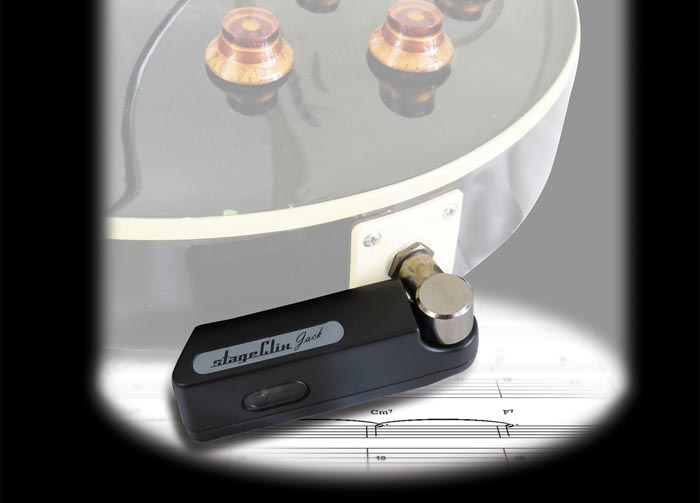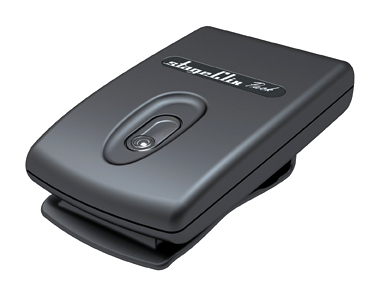With a sub-2.3ms latency, Dutch developer Systec Designs claims its 'stageClix' wireless guitar jack – which employs Nordic RF technology – is the lowest latency digital wireless audio adapter of its kind available in the world and is actually superior in many ways to a traditional hard-wired guitar-to-amplifier cable link
Ultra low power (ULP) RF specialist Nordic Semiconductor ASA announces that its RF technology has helped Dutch wireless ODM, System Designs BV, develop a wireless musical instrument jack that Systec claims at sub-2.3ms offers the world's lowest latency for a wireless audio adapter of its kind, and has resulted in a wireless solution that is actually superior to a traditional trailing cable, hard-wired link in audio quality and physical convenience.

The stageClix, which at $450 targets serious amateur and professional musicians, consists of a regular quarter-inch (6.3mm) jack plug transmitter on an articulated knuckle that plugs into the guitar and can be turned to siTt flat against it. The jack transmitter communicates with a metal receiver compatible with any guitar amp and which can also charge the jack plug transmitter when not in use.
A belt-pack worn option called the 'stageClix Pack' offers a microphone input for amplifying the output of acoustic instruments such as trumpets, saxophones, and acoustic guitars, and also supports a small belt-pack-to-guitar wire to accommodate a minority number of bass guitars whose poorly RF-shielded active electronics can be influenced by the RF field of the stageClix transmitter if plugged directly into the guitar.

The use of ultra low power Nordic transceivers enables the unpowered transmitter jack that plugs into a guitar to deliver up to 15 hours continuous use when powered from a pair of built-in rechargeable AAA batteries.
In operation, the stageClix offers 'plug & play' simplicity and employs a patent-pending anti-interference protocol technique Systec calls 'triple-diversity'. This streams audio over three 'frequency hopped' channels that are widely spaced across a total of 80 available Nordic channels. Using a technique similar to RAID-style redundancy from the high-end PC server industry, 'reconstruction' of lost data packets from any two of the three hopped frequency channels is possible. Alongside this ‘RAID-redundancy-principle’ a second algorithm is used to take care of ‘intelligent interpolation’ in case full reconstruction of data packets by the primary ‘RAID-algorithm’ fails for whatever reason.
This – according to Systec – results in a world-leading latency of 2.3ms that eliminates issues such as fadeouts, dropouts, and 'pops' that often plague wireless musical instrument jacks. "All wireless systems traditionally struggle with fast, attacking 'transient' notes that can be flattened out by analog systems or become noticeably slowed and subdued by digital systems if the latency of the link according to our experience is anything above 3ms," explains Harry Visser, one of the design engineers behind the stageClix. "This can leave musicians feeling disconnected from their instruments when playing and probably explains the slow uptake of wireless jacks to date."
Visser continues:
"Our stageClix solution finally solves the problem and by eliminating the natural muffling effect stemming from the electrical impedance of a traditional cable that is typically as high as 0.2nF per meter of cable – our wireless solution offers greater clarity, responsiveness, and insight. This is particularly relevant for longer cable lengths used during performances that can easily exceed 1nF of load-impedance to the electrical guitar's output signal.
Systec says proof of these claims came when Dutch guitarist magazine 'De Gitarist' did a group test of three leading wireless guitar jacks, and the stageClix came out as the clear winner for its "rechargeability, robust construction, and above all else: audio quality."
Visser admits that the only real issue – as with all wireless audio operating within the busy 2.4GHz band – is interference in exceptionally busy RF concert environments with, for example, numerous 2.4GHz Wi-Fi base stations, wireless 2.4GHz security cameras, and wireless 2.4GHz earpiece and microphones that are popular among security staff.
"This can reduce the maximum free-air range from 200m+ down to as low as 10m, "which for the vast majority of live stage performances is completely acceptable and can be increased by adjusting the 'frequency-triplets' used by the stageClix at the touch of a button," says Visser.